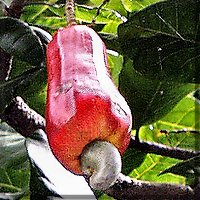
Anacardium occidentale

Anacardium occidentale
Origin - The cashew is a hardy drought-resistant tropical or subtropical tree whose growth is limited to the area of our continent from Mexico to Peru and Brazil, but includes Hawaii, Puerto Rico, and favored parts of the southern tip of Florida. Worldwide, India is the leading producer; other producing countries include Mozambique and Tanzania
Description - The Cashew tree, known by the latin name Anacardium occidentale, is a member of the Anacardiaceae floral family, which includes the mango tree, pistachio tree, poison ivy and poison oak. The Anacardiaceae family contains 73 genera and 600 species. Anacardium contains eight species which are all native to South America. The cashew tree is a small to medium tree, generally single-trunked and spreading in habit, up to 40' in height but generally 10-20' in cultivation. In older trees, spread may be greater than height, with lower limbs bending to touch the ground. Leaves are thick, prominently veined, oval to spatulate in shape, with blunt tips and entire margins. New foliage contains reddish pigment.
Flowering for the cashew tree is similar to the close relative mango tree: both male and perfect flowers are born in the same inflorescence (polygamous). Individual flowers are 1/4" across, with crimson petals, often striped longitudinally and reflexed. They are borne terminally on panicles, generally at the beginning of the dry season. Flowering may occur over several weeks, and it is not uncommon to have ripening fruit and flowers on the tree at the same time.
Common Names - Cajueiro, cashu, casho, acajuiba, caju, acajou, acaju, acajaiba, alcayoiba, anacarde, anacardier, anacardo, cacajuil, cajou, gajus, jocote maranon, maranon, merey, noix d’acajou, pomme cajou, pomme, jambu, jambu golok, jambu mete, jambu monyet, jambu terong
Other Uses - Many parts of the cashew plant are used:
Medicinal Uses - The cashew tree and its nuts and fruit have been used for centuries by the indigenous tribes of the rainforest, and it is a common cultivated plant in their gardens.
Pharmacology - Per 100 g, the mature seed is reported to contain 542 calories, 7.6 g H2O, 17.4 g protein, 43.4 g fat, 29.2 g total carbohydrate, 1.4 g fiber, 2.4 g ash, 76 mg Ca, 578 mg P, 18.0 mg Fe, 0.65 mg thiamine, 0.25 mg riboflavin, 1.6 mg niacin, and 7 mg ascorbic acid. Per 100 g, the mature seed is reported to contain 561 calories, 5.2 g H2O, 17.2 g protein, 45.7 g fat, 29.3 g total carbohydrate, 1.4 g fiber, 2.6 g ash, 38 mg Ca, 373 mg P, 3.8 mg Fe, 15 mg Na, 464 mg K, 60 mg b-carotene equivalent, 0.43 mg thiamine, 0.25 mg riboflavin, and 1.8 mg niacin. Per 100 g, the mature seed is reported to contain 533 calories, 2.7 g H2O, 15.2 g protein, 37.0 g fat, 42.0 g total carbohydrate, 1.4 g fiber, 3.1 g ash, 24 mg Ca, 580 mg P, 1.8 mg Fe, 0.85 mg thiamine, 0.32 mg riboflavin, and 2.1 mg niacin. The apple contains 87.9% water, 0.2% protein, 0.1% fat, 11.6% carbohydrate, 0.2% ash, 0.01% Ca, 0.01% P, .002% Fe, 0.26% vitamin C, and 0.09% carotene. The testa contains a-catechin, b-sitosterol, and 1-epicatechin; also proanthocyanadine leucocyanadine, and leucopelargodonidine. The dark color of the nut is due to an iron-polyphenol complex. The shell oil contains about 90% anacardic acid (C22H32O3 and 10% cardol (C32H27O4). It yields glycerides, linoleic, palmitic, stearic, and lignoceric acids, and sitosterol. Examining 24 different cashews, Murthy and Yadava (1972) reported that the oil content of the shell ranged from 16.6 to 32.9%, of the kernel from 34.5 to 46.8%. Reducing sugars ranged from 0.9 to 3.2%, non-reducing sugars, 1.3 to 5.8%, total sugars from 2.4 to 8.7%, starch from 4.7 to 11.2%. Gum exudates contain arabinose, galactose, rhamnose, and xylose.
Contra-indications and Toxity - The cashew nut is defined botanically as the fruit. It grows externally in its own kidney-shaped hard shell at the end of this pseudo-fruit, or peduncle. The nut kernel inside is covered with an inner shell, and between the two shells is a thick, caustic, and toxic oil called cardol. Cashew nuts must be cleaned to remove the cardol and then roasted or boiled to remove the toxins before they can be eaten.